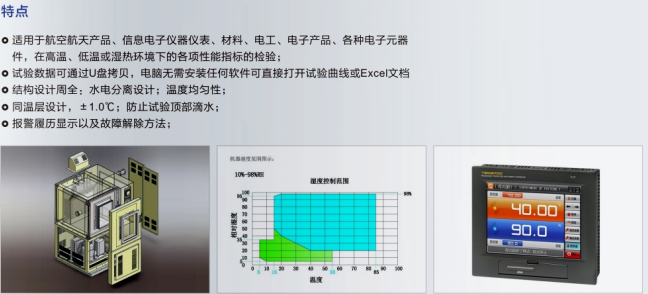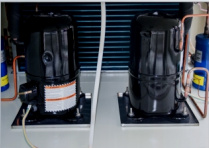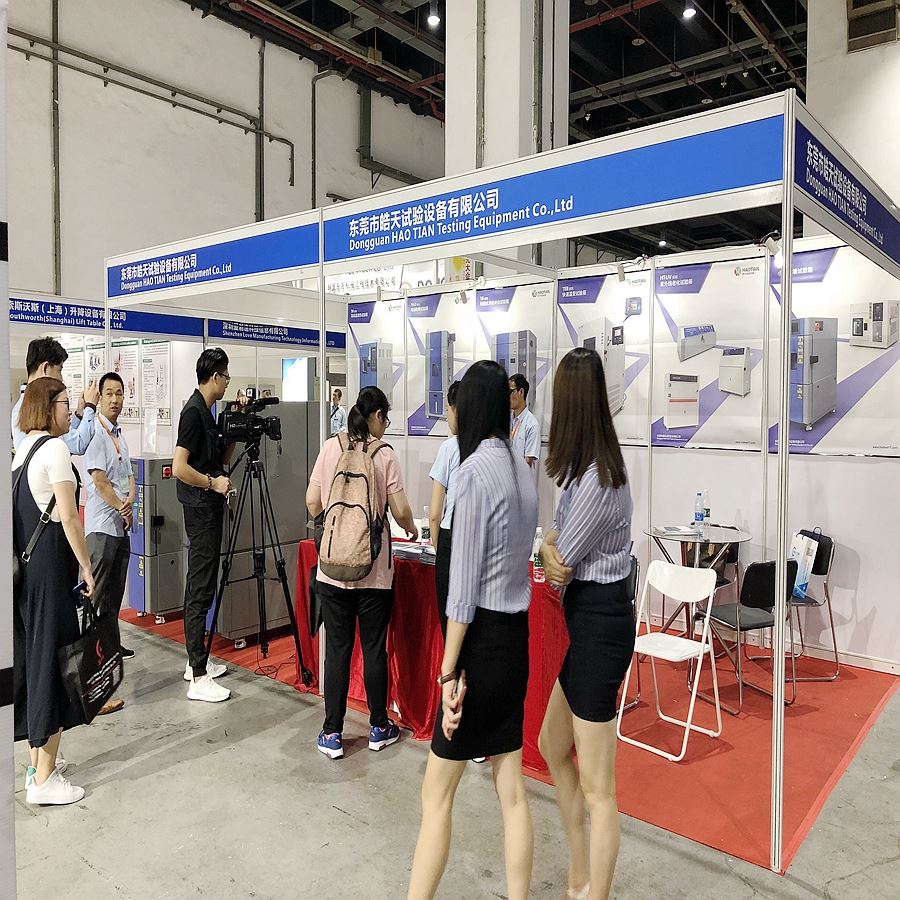Interpretation of high and low temperature control cycle test box safe operation specification
Interpretation of high and low temperature control cycle test box safe operation specification
Do you know how the high and low temperature test chambers should be operated correctly? If it is an unregulated operation, it will cause unnecessary troubles. In particular, it will suddenly fail or fail to open the machine. It may even lead to a decrease in the life of the test chamber. The following questions are answered by our Xiaotian Xiaobian: “How to correctly operate the cryogenic chamberâ€
First , high and low temperature test box boot steps:
Turn on the power of the power distribution cabinet.
Turn on the cooling tower power supply and water supply switch. (This step is unnecessary if it is air-cooled)
Close the "mains" switch of the chamber.
Press the "Power Switch" on the front panel of the machine and the control system will be powered on.
Second, note :
During operation, unless you absolutely need to, please do not open the door, otherwise it may lead to the following undesirable consequences:
1. High-temperature air blows out of the box and causes burns.
2. High temperature air may trigger a fire alarm and cause malfunction.
3. The inside of the door is still kept at a high temperature, causing burns.
4. When the test box is installed, the housing of the box must be grounded. If the test box is not grounded, it will be very dangerous if it leaks electricity.
5. Avoid closing and restarting the freezer within 15 minutes.
6. If a heat sample is placed in the box, use a power supply for the sample's power control. Do not use the power supply directly. When putting in high-temperature sample for low-temperature test, it should be noted that the time for opening the door should be as short as possible.
7. Circuit breakers and over-temperature protectors are provided for the safety protection of the local test products as well as the operators and need regular inspection.
8, absolutely prohibited the test explosive, flammable and highly corrosive substances.
9, lights open except when necessary, the rest of the time should be closed.
10. Before doing low temperatures, dry the studio.
11. In any section perpendicular to the prevailing wind direction, the sum of the test load cross-sectional area should not be greater than one-third of the work section at that location.

12. It is normal for the high and low temperature test chamber to have high smoke and odor exclusion when it is used for a high temperature within the first week. Because the test box is manufactured with the lubricating oil on the steel plate, the new test box is just starting to use high temperature. The odor produced when cooking fumes is roasted.
13. Do not open the studio door immediately after the test to avoid the impact of hot air on the operator. If you must remove the test sample immediately, you must wear insulated gloves to avoid burns.
14. All specimens should be placed evenly. Placement of the test should be within the effective space of the studio.
15. When plugging and unplugging the communication interface cable between the test box and the computer, you must first turn off the computer power and never allow hot plugging. Hot plugging may damage the instrument communication port or computer communication port.
16, the end of the test work, do not use the test box, be sure to bring the total power switch.
17. If the test box is not equipped with a humidification function, pay attention to the difference between the use and requirements when reading the instructions.
18, this series of products cooling method is air-cooled, for stand-alone and dual-machine, the instructions for the air-cooled, single, dual general purpose. When reading the instructions, pay attention to the difference between the use and requirements.
19. In the description, "R404A" refers to the "high temperature grade" in the refrigeration system, and "R23" refers to the "low temperature grade" in the refrigeration system. The used refrigerants are "R404A" and "R23", respectively.
20, test chamber with lighting function, lighting should not be lit. Some of the high temperature ovens do not have a lamp since the test temperature is above 150 degrees, and the switch on the panel is useless.
Three, before the inspection
Power and grounding line confirmation ;
The power input wire diameter must be equal to or greater than the required wire diameter. Otherwise, the load of the equipment during the operation is severe and it is easy to cause the load to burn out .
Is the power cord properly connected according to the specifications and confirm the grounding ?
Check the over-temperature protector, if it is set well (the factory has been adjusted, generally do not need to adjust) .
Fourth, fault self-test :
It is normal for the following phenomena to occur during the use of the test chamber. Please feel free to use it.
During the use of the equipment, the water pipes turn yellow, and water rust in the water tanks is caused by water rust that has been oxidized in the air for a long time. This is a normal phenomenon. Clean it with water. (Test water must use pure water or distilled water)
When the ambient temperature is too high, the cooling rate is relatively slow, which is a normal phenomenon.
It is normal for smoke and odor to be removed when the test chamber is used for high temperature within the first week. Because the test box is manufactured with the lubricating oil on the steel plate, the new test chamber will produce smoke when the temperature is just used. The odor that is roasted is normal.
The overpressure of the equipment is because the ambient temperature is too high. Please control the ambient temperature between 5~28°C and the place where the relative humidity is less than 85%.
Fifth, defrost function:
The high and low temperature test chamber will produce frost during testing of the test product. This will have a certain influence on the test. Therefore, the high and low temperature test chamber has the function of defrosting during the test. How the defrosting function and equipment of the LENPURE chamber are described today is how to defrost:
High and low temperature test chambers mainly defrost through the refrigeration of the compressor and condense the moisture in the air into ice crystals. The frost is mainly on the energy storage components in the precooling zone.
The high and low temperature test chamber exchanges heat mainly through the mutual conversion of the airflow in the box. The air inside the box is isolated from the air outside the box and closed. Since the box is closed, the moisture in the box is quantitative, so from a theoretical point of view, it is impossible to add some water to form a frost body, then where does this extra moisture come from?
During the test, the user opens the cabinet door of the cryogenic chamber, and the cabinet air forms an air exchange with the outside world. The moisture in the air enters the cabinet. Therefore, when using the high-low temperature tester during the product test, be careful not to open the door of the box at will. If it is opened, it will not only increase the number of frosts, but also cause uncertainty in the test data.

Sixth, equipment stability and refrigeration system:
The stability of the high-low temperature humidity-heat alternating test chamber is half from the manufacturer's design, which cannot be changed by the customer during use; the other half is the setting during use, which can be controlled by the customer himself. Whether the machine is good or not depends on how you use it. However, most of the users are not professionally trained and can only operate according to a paper specification. It is difficult to achieve an ideal state.
1. The stability of the high-low temperature humidity-heat alternating test box requires the cooling system of the high-low temperature damp heat alternating test box. The medium-temperature refrigerant used in the single-stage refrigeration cycle of the high-low temperature humidity-heat alternating test box is R404A. The evaporation temperature is -46.5°C under one atmospheric pressure, but the heat-transfer temperature difference of the air-cooled condenser is usually about 10°C. In other words, only a low temperature of -36.5°C can be produced in the box. What do you need to achieve a lower temperature? At this time, by lowering the evaporation pressure of the compressor, the minimum evaporation temperature of the R404A refrigerant can be reduced to -50°C. Therefore, in order to obtain a low temperature of -50°C or lower, medium-temperature refrigerant and low-temperature refrigerant must be used. Stacked refrigeration cycle, so as to ensure the stability of high and low temperature humidity heat alternating test chamber.
2. The cooling and dehumidification of the high-low temperature heat and humidity alternating test chamber are all accomplished by the refrigeration system. The same system can enable the machine to reach two different states. This is all based on the operation of the person, so the high and low temperature humidity heat is accurately set. The working system of the alternating test box is very important, and the reasonable and correct use can achieve the result you want.
3. The refrigeration system and the compressor of the high-low temperature damp heat alternating test box are complementary. The lowest evaporation temperature of the single-stage steam compression refrigerator mainly depends on its condensing pressure and compression ratio:
For any refrigerant, the lower the evaporation temperature, the lower the evaporation pressure.
When the evaporation temperature is too low, some common refrigerants have reached the solidification temperature, and the refrigerant flow and circulation cannot be realized.
The evaporation pressure decreases, the volume of the refrigerant increases, and the mass flow rate of the refrigerant decreases. At this time, in order to obtain the required cooling capacity, the suction volume must be increased to make the compressor bulky.
Seven, high and low temperature test box acceptance method:
1, the main test equipment and devices:
1.1 Anemometers: Anemometers with induction quantities not less than 0.05m/s:
1.2 Thermometer: A temperature measuring system composed of platinum resistance, thermocouple or other similar temperature sensor and meeting the following requirements: sensor time constant: 20S~40S; expanded uncertainty of temperature measurement system (K=2): not more than 0.4 °C:
1.3 Surface thermometer: A measuring system made of platinum resistance or other similar sensor and meeting the following requirements: sensor time constant: 20S~40S; expanded uncertainty of temperature measuring system (K=2): no more than 1.0°C:
2, test conditions:
2.1 Test under no-load conditions:
2.2 When performing the cooling rate test, the ambient temperature should not exceed 25°C, and the cold power temperature should not exceed 30°C:
3, temperature test methods:
3.1 Location and number of test points:
3.1.1 in the test chamber studio content set the upper, middle and lower levels of the test surface, referred to as the upper, middle and lower levels, the distance between the upper and the studio top is 1/10 of the studio height, the middle through the studio Geometry center, lower layer 10mm above the lowest sample holder:
3.1.2 The test points are located on three test surfaces. The center test point is located in the geometric center of the studio. The distance from the rest of the test points to the workroom wall is 1/10 of the length of each side, but the working space is not more than 1 cubic meter. Test box, the distance is not less than 50mm
3.1.3 The relationship between the number of test points and the size of the working chamber is: when the working chamber volume is no more than 2 cubic meters, the test point is 9; when the working chamber volume is more than 2 cubic meters, the test point is 15; when the high and low temperature When the laboratory chamber volume is greater than 50 cubic meters, the number of temperature test points may be increased as appropriate:
4, test program:
4.1 In the test chamber temperature adjustable range, select the high nominal temperature and the lowest nominal temperature:
4.2 The test box was run according to the procedure of high temperature after the first low temperature. The temperature at the center point of the working space reached the test temperature and was stable at 2H. The temperature of all the test points was tested at the first minute in 30 minutes for a total of 30 times:
5, data processing and test results:
5.1 The measured temperature data is corrected according to the test meter's correction value:
5.2 Remove suspicious data:
5.3 Calculate the average temperature of the measured value of 30 points per point for the data measured during the constant temperature phase:
5.4 Calculate Temperature Gradient: Maximum Temperature Average minus Minimum Temperature Average:
5.5 Calculate temperature fluctuations and temperature deviations:
5.6 The difference between the set value and the central test value of the control instrument of the high and low temperature test chamber should meet the tolerance requirement:
6. Test method for the temperature difference between the working room wall and the working space:
6.1 Location and Quantity of Test Points:
6.1.1 Place a temperature sensor in the center of the workspace. Place a surface temperature sensor in the geometric center of the inner wall of the six sides of the studio:
6.1.2 If there is a lead hole or other device in the center of the working room wall, the distance between the test point and the hole wall or other device should not be less than 100mm:
6.2 Test Procedure:
6.2.1 Within the adjustable range of the test chamber temperature, use the high nominal temperature and the lowest nominal temperature as the test temperature:
6.2.2 The temperature at the geometric center point of the working space reaches the test temperature for the first time and is stable at 2H. The temperature values ​​of all the test points are tested every 2 minutes for a total of 5 times:
6.3 Calculation and Evaluation of Test Results:
6.3.1 Correct the test temperature value according to the test meter's correction value:
6.3.2 Calculate the arithmetic mean of each test point temperature separately:
6.3.3 Calculate the percentage of the difference between the thermodynamic temperature of the Studio Siberian wall and the studio:
7, rising, cooling rate test methods:
The 7.1 test point is the geometric center of the workspace:
7.2 Test Procedure:
7.2.1 Within the adjustable temperature range of the high and low temperature test chamber, the lowest nominal temperature is selected as the minimum specified temperature, and the high nominal temperature is the specified temperature:
7.2.2 Turn on the cold source, reduce the test chamber from room temperature to the minimum specified temperature, stabilize 2H, adjust the temperature to the specified temperature, and measure the temperature of the test chamber from 10% to 90% of the temperature range; make the test chamber at a high specified temperature. Next, stabilize 2H, and then adjust to the lowest specified temperature. Test the temperature of the test chamber from 90% of the temperature range to 10%:
7.2.3 Record the temperature value every 1 minute during the heating or cooling process.
Dongguan Haotian participated in the 6th Shanghai International Testing Machine and Environmental Testing Equipment Exhibition at Shanghai Everbright Expo from June 12th to June 14th .

                  Shanghai Exhibition site picture
Nantong Gympro Sports Co.,Ltd , https://www.sportsgympro.com